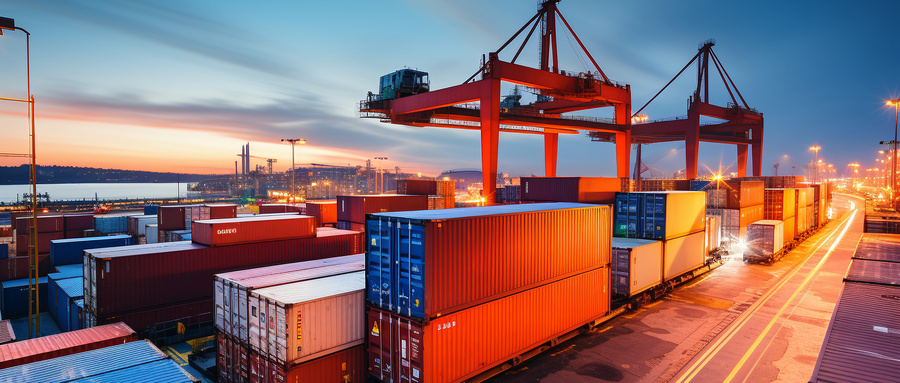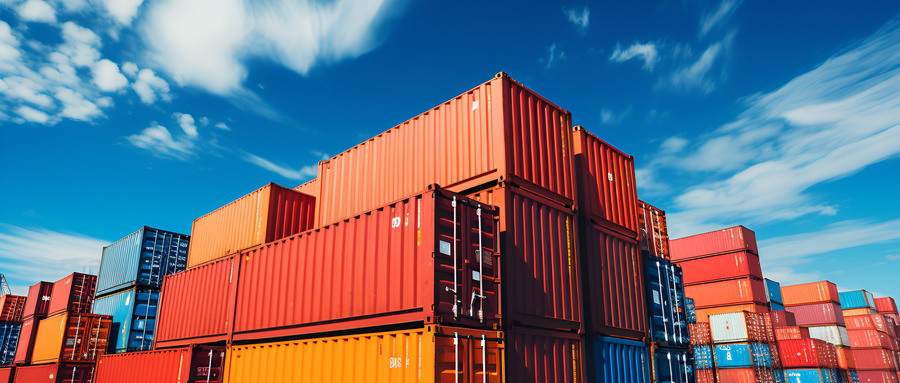

Several countries have proposed restrictions on Chinese-made port equipment
For a long time, in the field of port handling equipment, containers and other port equipment manufacturing, inexpensive Chinese enterprises have occupied an absolute dominant position. The global market share of Zhenhua Heavy Industry's shore bridge products exceeded 70%, maintaining the first place for 26 consecutive years; In 2023, the global share of containers made in China is about 96%. But it is in these two strong areas that the "obstacles" of Chinese enterprises have come.
Previously, the US government has a number of targeted measures, on February 21, Biden pledged to spend $20 billion to replace the Chinese shore bridge in the US port, and introduce a trusted Japanese company (that is, Mitsui E&S subsidiary PACECO) to build the shore bridge in the United States.
On April 17, the United States launched a Section 301 investigation into China's conduct, policies and practices in the maritime, logistics and shipbuilding sectors, including port equipment; On May 14, the US government released the results of a four-year review of the 301 tariffs imposed on China, raising the tax rate on onshore Bridges imported from China from 0% to 25%.
Other countries, not just the United States, have some implicit or overt restrictions. India has long required security clearance for Chinese-made port machines. The German government's lack of explicit restrictions but its requirements for cumbersome documentation have prompted some operators to switch to equipment from manufacturers such as Liebherr; South Korea has also carried out an inventory of Chinese port machinery, and preferred local factories, and the yard bridge and shore bridge purchased by its first fully automated terminal are locally manufactured.
In the field of container manufacturing, restrictions and competition are also increasing, and almost every year there are proposals by US lawmakers to target China's monopoly position in container production. In 2022, the United States blocked CIMC's acquisition of Maersk's cold box manufacturing business on antitrust grounds, and the Financial Times said German regulators were also considering blocking the deal.
Port and shipping equipment manufacturing is still quite dependent on labor, the proportion of material costs is high, it is difficult for foreign manufacturers to compete with the low-price strategy of Chinese enterprises. From the industrial chain supporting, the complete industrial layout and labor cost advantages have also attracted other foreign equipment manufacturers to use Chinese outsourcers.
In 2023, Zhenhua Heavy Industry in the port machinery business, materials, labor costs and other manufacturing expenses accounted for more than 60% of the total cost, the gross margin of 16.33%, in the port machinery enterprises, the fierce competition in the mainland, the gross margin is only 10.26%. In the field of container manufacturing, steel costs also account for the majority, in 2023, CIMC's container manufacturing business gross margin of 15.97%.
Low gross margins mean low prices, and global companies that source these products are reluctant to add additional costs. The American Association of Port Authorities has repeatedly stated that China has found no cybersecurity issues and called for the tariffs to be lifted. In a preliminary study, 33 U.S. port authorities and terminal operators plan to purchase 61 shore Bridges in the next five years, based on an average price of $15 million per unit, which will require an additional $131 million, which will discourage investment in U.S. ports.
On the one hand, Konecranes, PACECO and other companies take several years to form capacity, on the other hand, industry estimates that due to higher costs, the price of shore Bridges in the United States may be 2-2.5 times higher than in China. In 2022, the U.S. Army solicited bids for two U.S.-built small shore Bridges (only 13Row), winning bids of up to $48 million, or $24 million each.
The US shore bridge does not have any advantage in cost, and the market share of other companies also shows that in other regional markets, their price competitiveness is not enough, such as Indian terminal operators through various means to bypass government restrictions, Adani Group's automated port soon opened the port, using Zhenhua Heavy Industry's shore bridge.
However, when the government stepped in, port equipment was no longer a cost priority. The governments of the United States, South Korea and other countries actively support the port machinery manufacturing industry, and South Korea also supports enterprises to build factories to manufacture containers in Southeast Asia. With the increasingly strong trend of "decoupling", under the intervention of non-market-oriented means such as subsidies and tariffs, the living space of China's port equipment manufacturing enterprises is inevitably backloaded.
Moreover, Chinese enterprises have no obvious technical advantages in onshore bridge and container manufacturing, such as onshore bridge manufacturing is more like an integrated work, core components, motor control systems, etc., often rely on international enterprises, willing to find substitutes at the cost, many port enterprises even have their own port equipment groups.
Chinese enterprises have their own opportunities, such as the domestic large-scale equipment renewal action, to provide financial and tax support initiatives, many provinces have issued updates of port and shipping equipment, such as Zhejiang Province plans to update 70 sets of port machinery and equipment by 2027. However, in the broader international market, market barriers in some regions are getting higher and higher, and it is better to cultivate core advantages that are difficult to replace and find new growth opportunities with low prices in the suppressed shore bridge and container manufacturing fields. Zhenhua Heavy Industry and CIMC Group have relevant strategic deployment, such as Zhenhua Heavy Industry's intelligent and low-carbon upgrading of port machinery, entering more flow machine segments; Cimc develops scenario-based logistics equipment and container + products around containers, all of which are transforming to more high-end and higher-margin equipment solutions. Now, it's time to grab new markets.

Previously, the US government has a number of targeted measures, on February 21, Biden pledged to spend $20 billion to replace the Chinese shore bridge in the US port, and introduce a trusted Japanese company (that is, Mitsui E&S subsidiary PACECO) to build the shore bridge in the United States.
On April 17, the United States launched a Section 301 investigation into China's conduct, policies and practices in the maritime, logistics and shipbuilding sectors, including port equipment; On May 14, the US government released the results of a four-year review of the 301 tariffs imposed on China, raising the tax rate on onshore Bridges imported from China from 0% to 25%.
Other countries, not just the United States, have some implicit or overt restrictions. India has long required security clearance for Chinese-made port machines. The German government's lack of explicit restrictions but its requirements for cumbersome documentation have prompted some operators to switch to equipment from manufacturers such as Liebherr; South Korea has also carried out an inventory of Chinese port machinery, and preferred local factories, and the yard bridge and shore bridge purchased by its first fully automated terminal are locally manufactured.
In the field of container manufacturing, restrictions and competition are also increasing, and almost every year there are proposals by US lawmakers to target China's monopoly position in container production. In 2022, the United States blocked CIMC's acquisition of Maersk's cold box manufacturing business on antitrust grounds, and the Financial Times said German regulators were also considering blocking the deal.

Port and shipping equipment manufacturing is still quite dependent on labor, the proportion of material costs is high, it is difficult for foreign manufacturers to compete with the low-price strategy of Chinese enterprises. From the industrial chain supporting, the complete industrial layout and labor cost advantages have also attracted other foreign equipment manufacturers to use Chinese outsourcers.
In 2023, Zhenhua Heavy Industry in the port machinery business, materials, labor costs and other manufacturing expenses accounted for more than 60% of the total cost, the gross margin of 16.33%, in the port machinery enterprises, the fierce competition in the mainland, the gross margin is only 10.26%. In the field of container manufacturing, steel costs also account for the majority, in 2023, CIMC's container manufacturing business gross margin of 15.97%.
Low gross margins mean low prices, and global companies that source these products are reluctant to add additional costs. The American Association of Port Authorities has repeatedly stated that China has found no cybersecurity issues and called for the tariffs to be lifted. In a preliminary study, 33 U.S. port authorities and terminal operators plan to purchase 61 shore Bridges in the next five years, based on an average price of $15 million per unit, which will require an additional $131 million, which will discourage investment in U.S. ports.
On the one hand, Konecranes, PACECO and other companies take several years to form capacity, on the other hand, industry estimates that due to higher costs, the price of shore Bridges in the United States may be 2-2.5 times higher than in China. In 2022, the U.S. Army solicited bids for two U.S.-built small shore Bridges (only 13Row), winning bids of up to $48 million, or $24 million each.
The US shore bridge does not have any advantage in cost, and the market share of other companies also shows that in other regional markets, their price competitiveness is not enough, such as Indian terminal operators through various means to bypass government restrictions, Adani Group's automated port soon opened the port, using Zhenhua Heavy Industry's shore bridge.
However, when the government stepped in, port equipment was no longer a cost priority. The governments of the United States, South Korea and other countries actively support the port machinery manufacturing industry, and South Korea also supports enterprises to build factories to manufacture containers in Southeast Asia. With the increasingly strong trend of "decoupling", under the intervention of non-market-oriented means such as subsidies and tariffs, the living space of China's port equipment manufacturing enterprises is inevitably backloaded.
Moreover, Chinese enterprises have no obvious technical advantages in onshore bridge and container manufacturing, such as onshore bridge manufacturing is more like an integrated work, core components, motor control systems, etc., often rely on international enterprises, willing to find substitutes at the cost, many port enterprises even have their own port equipment groups.
Chinese enterprises have their own opportunities, such as the domestic large-scale equipment renewal action, to provide financial and tax support initiatives, many provinces have issued updates of port and shipping equipment, such as Zhejiang Province plans to update 70 sets of port machinery and equipment by 2027. However, in the broader international market, market barriers in some regions are getting higher and higher, and it is better to cultivate core advantages that are difficult to replace and find new growth opportunities with low prices in the suppressed shore bridge and container manufacturing fields. Zhenhua Heavy Industry and CIMC Group have relevant strategic deployment, such as Zhenhua Heavy Industry's intelligent and low-carbon upgrading of port machinery, entering more flow machine segments; Cimc develops scenario-based logistics equipment and container + products around containers, all of which are transforming to more high-end and higher-margin equipment solutions. Now, it's time to grab new markets.





